Single-cell transcriptomic atlas of primate cardiopulmonary aging
- PMID: 32913304
- PMCID: PMC7483052
- DOI: 10.1038/s41422-020-00412-6
Single-cell transcriptomic atlas of primate cardiopulmonary aging
Abstract
Aging is a major risk factor for many diseases, especially in highly prevalent cardiopulmonary comorbidities and infectious diseases including Coronavirus Disease 2019 (COVID-19). Resolving cellular and molecular mechanisms associated with aging in higher mammals is therefore urgently needed. Here, we created young and old non-human primate single-nucleus/cell transcriptomic atlases of lung, heart and artery, the top tissues targeted by SARS-CoV-2. Analysis of cell type-specific aging-associated transcriptional changes revealed increased systemic inflammation and compromised virus defense as a hallmark of cardiopulmonary aging. With age, expression of the SARS-CoV-2 receptor angiotensin-converting enzyme 2 (ACE2) was increased in the pulmonary alveolar epithelial barrier, cardiomyocytes, and vascular endothelial cells. We found that interleukin 7 (IL7) accumulated in aged cardiopulmonary tissues and induced ACE2 expression in human vascular endothelial cells in an NF-κB-dependent manner. Furthermore, treatment with vitamin C blocked IL7-induced ACE2 expression. Altogether, our findings depict the first transcriptomic atlas of the aged primate cardiopulmonary system and provide vital insights into age-linked susceptibility to SARS-CoV-2, suggesting that geroprotective strategies may reduce COVID-19 severity in the elderly.
Conflict of interest statement
The authors declare no competing interests.
Figures
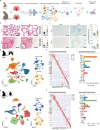
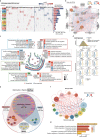
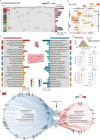
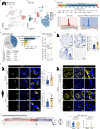
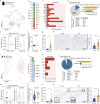

Comment in
-
SARS-CoV-2 leads to myocardial injury in rhesus macaque.Signal Transduct Target Ther. 2021 Sep 6;6(1):338. doi: 10.1038/s41392-021-00747-5. Signal Transduct Target Ther. 2021. PMID: 34489396 Free PMC article. No abstract available.
Similar articles
-
SARS-CoV-2 Spike Protein Destabilizes Microvascular Homeostasis.Microbiol Spectr. 2021 Dec 22;9(3):e0073521. doi: 10.1128/Spectrum.00735-21. Epub 2021 Dec 22. Microbiol Spectr. 2021. PMID: 34935423 Free PMC article.
-
A human pluripotent stem cell-based model of SARS-CoV-2 infection reveals an ACE2-independent inflammatory activation of vascular endothelial cells through TLR4.Stem Cell Reports. 2022 Mar 8;17(3):538-555. doi: 10.1016/j.stemcr.2022.01.015. Epub 2022 Feb 17. Stem Cell Reports. 2022. PMID: 35180397 Free PMC article.
-
Single-cell transcriptional profile of ACE2 in healthy and failing human hearts.Sci China Life Sci. 2021 Apr;64(4):652-655. doi: 10.1007/s11427-020-1787-5. Epub 2020 Sep 1. Sci China Life Sci. 2021. PMID: 32880862 Free PMC article. No abstract available.
-
Epithelial and Endothelial Expressions of ACE2: SARS-CoV-2 Entry Routes.J Pharm Pharm Sci. 2021;24:84-93. doi: 10.18433/jpps31455. J Pharm Pharm Sci. 2021. PMID: 33626315 Review.
-
Role of angiotensin-converting enzyme 2 in neurodegenerative diseases during the COVID-19 pandemic.Aging (Albany NY). 2020 Nov 10;12(23):24453-24461. doi: 10.18632/aging.103993. Epub 2020 Nov 10. Aging (Albany NY). 2020. PMID: 33197881 Free PMC article. Review.
Cited by
-
The landscape of aging.Sci China Life Sci. 2022 Dec;65(12):2354-2454. doi: 10.1007/s11427-022-2161-3. Epub 2022 Sep 2. Sci China Life Sci. 2022. PMID: 36066811 Free PMC article. Review.
-
Endothelial dysfunction in COVID-19: an overview of evidence, biomarkers, mechanisms and potential therapies.Acta Pharmacol Sin. 2023 Apr;44(4):695-709. doi: 10.1038/s41401-022-00998-0. Epub 2022 Oct 17. Acta Pharmacol Sin. 2023. PMID: 36253560 Free PMC article. Review.
-
SARS-CoV-2 mechanisms of cell tropism in various organs considering host factors.Heliyon. 2024 Feb 20;10(4):e26577. doi: 10.1016/j.heliyon.2024.e26577. eCollection 2024 Feb 29. Heliyon. 2024. PMID: 38420467 Free PMC article. Review.
-
Cross-species metabolomic analysis identifies uridine as a potent regeneration promoting factor.Cell Discov. 2022 Feb 1;8(1):6. doi: 10.1038/s41421-021-00361-3. Cell Discov. 2022. PMID: 35102134 Free PMC article.
-
Aging-induced immune microenvironment remodeling fosters melanoma in male mice via γδ17-Neutrophil-CD8 axis.Nat Commun. 2024 Dec 30;15(1):10860. doi: 10.1038/s41467-024-55164-3. Nat Commun. 2024. PMID: 39738047 Free PMC article.
References
MeSH terms
Substances
LinkOut - more resources
Full Text Sources
Medical
Miscellaneous

